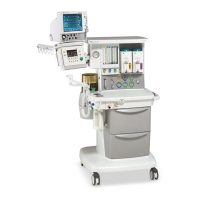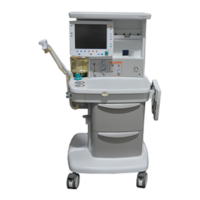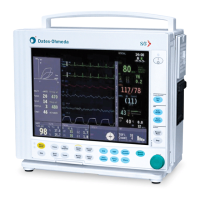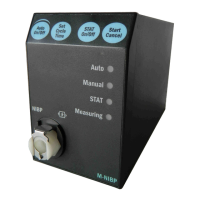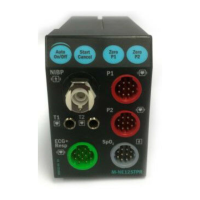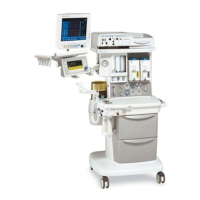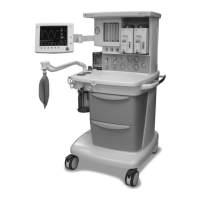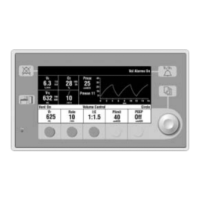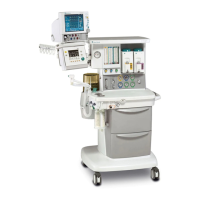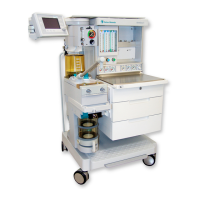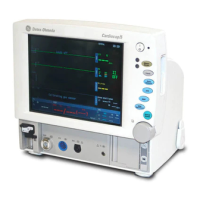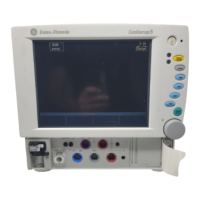Do you have a question about the Datex-Ohmeda S/5 Aespire and is the answer not in the manual?
Instructions for setting up the absorber canister, including handling and preparation.
Guidance on determining when to replace the absorbent material in the canister.
Procedure for safely removing the absorber canister from the breathing system.
Steps for refilling the reusable absorber canister with absorbent material.
Details on connecting the system's pneumatic and electrical components for operation.
Procedure for installing gas cylinders and performing a high-pressure leak test.
Information regarding DIN connections for gas supply and their proper use.
Important notes and checks performed by the Datex-Ohmeda representative during installation.
Guidance on safely attaching external equipment to the top shelf of the system.
Lists parts of the breathing system that can be cleaned and their procedures.
Specific requirements and precautions for cleaning and disinfecting system components.
Detailed procedure for cleaning and disinfecting the flow sensors.
Instructions for sterilizing components using CIDEX solution.
Step-by-step instructions for a specific cleaning or sterilization procedure.
Instructions for removing the breathing system bag hose.
Procedure for safely removing the entire breathing system assembly.
Steps to disassemble the breathing system for cleaning or repair.
Procedure for disassembling the bellows assembly.
Steps to correctly reassemble the bellows assembly.
Tests to perform after assembling the bellows to ensure proper function.
Instructions for reassembling the breathing system components.
Procedure for installing the reassembled breathing system.
Steps to remove the AGSS receiver for cleaning or servicing.
Procedure for removing and replacing the AGSS receiver filter.
Details on cleaning and maintaining the absorber canister.
Guidelines and policies for equipment repair and service by authorized personnel.
Overview of scheduled maintenance tasks and their recommended frequencies.
Tasks that users can perform for routine maintenance of the system.
Procedures for maintaining the breathing system, including component checks.
Step-by-step guide for replacing the O2 sensor.
Procedure for calibrating the O2 sensor to ensure accurate readings.
Procedure for calibrating the O2 sensor with 21% oxygen.
Procedure for calibrating the O2 sensor with 100% oxygen.
Instructions for calibrating the Paw (airway pressure) sensor.
Process for zeroing the flow sensors for accurate measurements.
Guidance on preventing water buildup in the system and its causes.
Explains alarm priorities, tones, and general causes of alarms.
A comprehensive list of alarm messages, their causes, and recommended actions.
Troubleshooting guide for issues with the breathing system that do not trigger alarms.
Guidance for diagnosing and resolving electrical issues and power failures.
Troubleshooting steps for pneumatic issues, including leaks and pressure failures.
Details on the adjustable ranges and default settings for system alarms.
Lists part numbers for the Bag Arm assembly and its manual bag.
Lists part numbers for breathing system components like bellows and seals.
Details part numbers for flow sensor modules, covers, and adapters.
Lists part numbers for the breathing circuit module and manifold.
Lists part numbers for absorbent canisters and related components.
Provides part number for the exhalation valve assembly.
Lists part numbers for the Bag-to-Vent switch assembly and cover.
Details part numbers for the APL valve assembly and its cover.
Lists part numbers for the AGSS (Active Gas Scavenging System) components.
Lists part numbers for test tools and general system parts.
Diagram and explanation of the system's pneumatic circuits.
Detailed specifications for the system's pneumatic and gas supply components.
Information on power supply, circuit breakers, and leakage current limits.
Details on EMC compliance and guidance for electromagnetic environments.
Dimensions, weight, and other physical characteristics of the system.
Specifications for operating and storage conditions like temperature and humidity.
Technical specifications for the breathing system, including volume and leakage.
Explanation of the ventilator's pneumatic principles and operation.
Explains the different ventilation modes: Volume and Pressure control.
Data on ventilation performance, including pneumatics and gas sources.
Accuracy specifications for delivery and monitoring functions of the ventilator.
Specifications for optional suction regulators.
Specifications for the optional auxiliary O2 flowmeter.
| Type | Anesthesia Machine |
|---|---|
| Model | S/5 Aespire |
| Manufacturer | Datex-Ohmeda |
| Flowmeter Type | Electronic |
| Ventilation Modes | Volume Control, Pressure Control, SIMV, Manual |
| Tidal Volume Range | 20-1500 ml |
| Oxygen Concentration | 21 to 100% |
| Vaporizer Capacity | Up to two vaporizers |
| Absorber Capacity | 1.5 kg |
| Integrated Monitoring | Optional |
| Gas Inlets | O2, Air, N2O |
